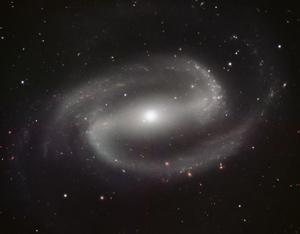A very important aspect of astronomy often overlooked is how much our eyes don’t tell us. We see a very limited range of the spectrum of light emitted by astronomical objects, and many times it’s what we don’t see that tells us what’s going on.
That’s why the European Southern Observatory has the HAWK-I camera: it sees in the infrared, in wavelengths invisible to our eyes. And when we train it on the skies, well, we see some pretty cool stuff. Like, say, gorgeous spiral galaxies:
[Click to galactinate.]
That’s NGC 1232, an open face-on spiral some 65 million light years away. This to me is a perfect spiral: the arms are distinct and easy to trace, starting near the center and going all the way around the galaxy. Several spurs – short, disconnected, straighter offshoots – can be seen. There’s also a bar: the center of the galaxy isn’t a sphere, it’s elongated in an oval.
All of these features are due to the weird gravitational field of a galaxy. In our solar system, the Sun dominates in the gravity department, and the planets orbit it. In a big galaxy, though, the gravity of every star adds up, making the force of gravity stronger farther from the center than if all the mass were concentrated there. This causes all sorts of odd manifestations like the bar, the spirals, and the spurs. I have a blog post discussing this in more detail, if you’d like to read that.
Incidentally, given the distance of NGC 1232 of 65 million light years, the photons you are seeing from this galaxy in this image left it when dinosaurs still roamed the Earth… but their time was juuuuussssst about up.
 HAWK-I was used to study several galaxies, and not just NGC 1232– five more, in fact, for this particular study, but I want to point out one in particular: NGC 1300, a magnificent elongated spiral, shown here on the right. The bar in this one dominates, stretching over a much larger relative distance than the one in NGC 1232, which is dinky in comparison.
HAWK-I was used to study several galaxies, and not just NGC 1232– five more, in fact, for this particular study, but I want to point out one in particular: NGC 1300, a magnificent elongated spiral, shown here on the right. The bar in this one dominates, stretching over a much larger relative distance than the one in NGC 1232, which is dinky in comparison.
As I mentioned above, we can learn a lot when we compare light from objects in different wavelengths. Here is that same HAWK-I infrared image of NGC 1300, with a Hubble image in visible light below it. I rotated and scaled the top image to match Hubble’s:
Ignoring the difference in things like resolution (Hubble can see smaller objects) and such, there are still obvious differences. In the visible image, dust between stars is dark, because it blocks visible light. However, IR goes through it, so the dust disappears in the top image. The dust adds a lot of sculpting and contouring to the visible Hubble image, and that’s gone in the IR image, so the top one looks smoother. That’s no illusion! That’s real, and it’s telling us where the dust is.
As you’d expect, objects that look red in the Hubble image are also bright in the IR, but the blue stuff is much fainter and difficult to spot in the HAWK-I view. Blue is emitted by hot, young, massive stars, which is easy to spot in the visible. The yellow-red glow in the bottom image is from older, redder stars, and they are prominent in the top image. See how the very center of the galaxy is bright in the HAWK-I shot? That tells me that there are far more older stars there, right in the very center. Star formation must have shut down long ago right smack dab in the heart of NGC 1300, or else we’d still see blue stars there.
… or, alternatively, there are blue stars there, but the dust is so thick their light gets reddened, like the setting Sun looks red from haze in our air. There are ways of telling the difference, but I don’t think it can be done with images like this; we’d need spectra, which is a whole other story. Still, it once again shows that you need to look at objects in different ways if you want to figure out what’s happening with them.
Looking in the infrared tells us a lot more about what’s going on than visible alone. Combine that with ultraviolet, radio, X-ray, gamma-rays, and we get a much more complete picture of what the Universe is showing us. It’s more than a double rainbow; it’s the whole rainbow, and the best part is we really do know what it means.
Related posts:
- Barred for life
- HAWK-I peers into a stellar cocoon
- Setting the bar
- Sculpting a barred galaxy